DNA testing could reveal WWI Digger’s identit Thursday, August 28th, 2008
|
|
|
|
|
DNA tests could reveal the identity of a World War I Digger whose complete remains have been unearthed by British archeologists at an old battlefield site in Belgium.
_
The remains of the Australian soldier, thought to have been serving with the 3rd Division, were discovered on the site of the Battle of Messines, fought in June 1917.
_
War historian Mat McLachlan said the discovery was unique because the soldier was wearing his full battle kit and appeared to have been buried as a result of an artillery shell exploding nearby.
_
“This is unusual and important because it gives us great insight into the articles actually carried by Australian soldiers into battle,” Mr McLachlan told The Australian yesterday.
_
Mr McLachlan, a member of the archeological group No Man’s Land, said the soldier was found with his hand still grasping his standard-issue Lee Enfield rifle, which had the bayonet attached.
_
“It really is a snapshot of an Aussie soldier because he was killed, fell to the ground and covered with dirt and that was the last anyone saw of him until 90 years later when these guys dug him up,” he said.
_
Defence Minister Warren Snowdon said the Digger’s remains were held by the Belgian army and it was hoped that DNA tests could reveal his identity. It is likely his remains will be interred at one of the Commonwealth War Graves cemeteries in Belgium later this year.
_
Mark Dodd
The Australian
|
|
|
|
|
|
Filed under: A Dig Diary by
admin
Add a Comment »
|
|
A couple more images Friday, August 22nd, 2008
|
|
|
|
|
We shall aim to post some images of the other main excavation trenches at Plugstreet 2008 at some point over the weekend, but in the meantime, a couple more images of items found with the Australian.
_
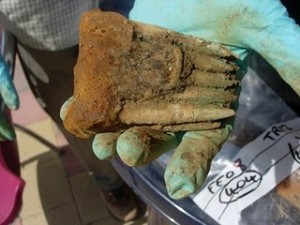
An image of one of the pockets of ammunition with chargers of .303 rounds and webbing attached to the pocket.
_
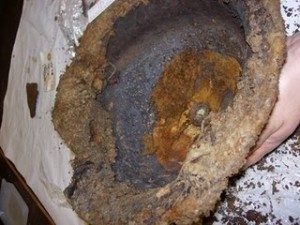
This is the interior of the brodie helmet note the buckles of the straps at the edge – with the mineralised strap thus up over the outer rim of the helmet
_
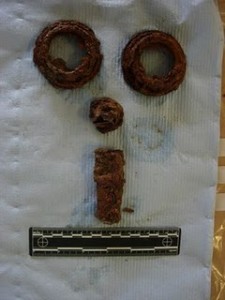
The components of the PH hood following initial conservation work
_
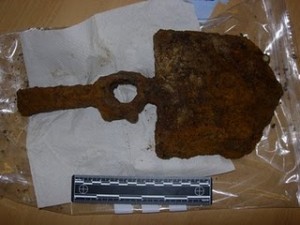
The entrenchment tool found at the back of the man, below his pack
_
|
|
|
|
|
|
Filed under: A Dig Diary by
admin
Add a Comment »
|
|
Some of the finds Wednesday, August 20th, 2008
|
|
|
|
|
In the following days we will aim to post some of the images from other important parts of the excavations of 2008. Today perhaps it would be worthwhile to show some of the finds with the man that was excavated
_
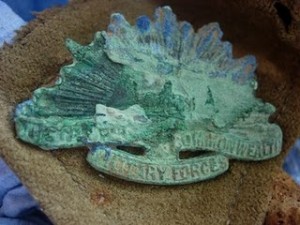 _
_
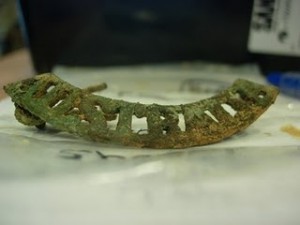
Proof of nationality (Collar badge and shoulder title)
_
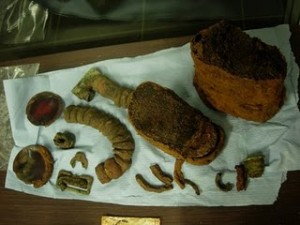
_
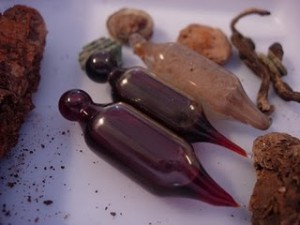
Box respirator and iodine under conservation
_
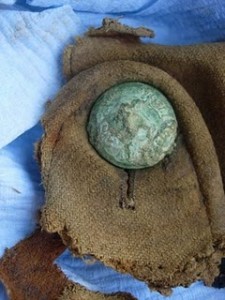
_
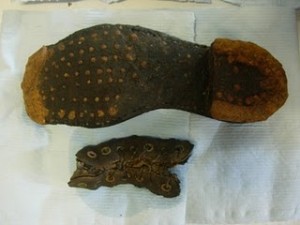
Button and Boot
_
We have posted these images as only a TINY portion of the kit found with the man to illustrate the quality of the surviving elements. Other parts of his panoply of arms are as well preserved and his remains too tell a story. We shall post more over the coming weeks
|
|
|
|
|
|
Filed under: A Dig Diary by
admin
2 Comments »
|
|
Ministerial Announcement in Australia Wednesday, August 20th, 2008
|
|
|
|
|
THE HON. WARREN SNOWDON MP Minister for Defence Science and Personnel
_
MISSING WORLD WAR ONE SOLDIER DISCOVERED IN BELGIUM
_
The Minister for Defence Science and Personnel, the Hon. Warren Snowdon MP, today announced the remains of an unidentified Australian World War I soldier have been unearthed in Belgium.
_
The human remains were discovered along with pieces of Australian equipment and clothing during an authorised excavation by a British archaeology team at Ploegsteert; the site where the Battle of Messines took place in June 1917.“I can confirm the remains of one of our courageous World War I soldiers have been uncovered in Belgium,” Mr Snowdon said.“Two British archaeologists undertaking an official excavation unearthed the remains, along with evidence they are of a fallen Australian Digger who fought in the Battle of Messines.”
_
The bones, which are reported to be in reasonably good condition, were exhumed under the supervision of the Belgian Police and Army, who are housing the remains at a Belgian Army Barracks until further notice from Australian authorities.
_
“The Australian Government is firm in our commitment to honour our war dead, and is already undertaking historical research to establish any initial identification links,” Mr Snowdon said.“We are also hopeful that some of the equipment located with the remains, such as badges and buttons, may assist with identification of the soldier and will consider the possibility of DNA testing if there is reasonable chance of a match.”
_
It is likely the remains will be re-interred at one of the existing Commonwealth War Graves Cemetery in Belgium later this year.
|
|
|
|
|
|
Filed under: A Dig Diary by
admin
Add a Comment »
|
|
An Announcement Wednesday, August 20th, 2008
|
|
|
|
|
Ladies and Gentlemen it is with some pride that I am able to now make this announcement…
_
_
No Longer Missing in Action:
_
No-Man’s-Land Archaeology recovers the body of an Australian soldier of the Great War
_
On 6th August 2008, No-Man’s-Land Archaeology, a multi-national archaeology group who specialise in the First World War, found the body of an Australian soldier of the Great War whilst excavating German trenches near St Yves in Wallonia, Belgium. The soldier was in full battle order with all his well-preserved equipment, medical kit, weaponry and parts of his uniform. His shoulder and collar titles identified him as an Australian. The area was attacked by the Australian 3rd Division on the morning of 7th June 1917 as part of the Battle of Messines, a prelude to the better known battle of 3rd Ypres (Passchendaele). Unlike recent discoveries at Fromelles, this was a battlefield casualty in full kit buried where he fell rather than a burial in a grave behind the lines.
_
The work is part of a wider landscape project to examine the effectiveness of the training of the Australian 3rd Division on Salisbury Plain in Wiltshire with the actuality of battle through archaeological excavation of trench systems, historical studies, aerial photography, map work, geophysical survey and other techniques. The project has run for four years so far, with this being the second season of fieldwork in Belgium and the first time that significant human remains were recovered. The work has been accomplished by a multinational team in collaboration with a number of academic departments and local partners.
_
The remains of the soldier tell a significant story of one man’s involvement in a major piece of world history through his personal kit and effects including the evidence for the taking of trophies in the form of a German pickelhaube. The body was recovered with scientific techniques; geophysical survey, forensic archaeology (techniques familiar to viewers of CSI), and on-site conservation from our mobile lab.
_
The group is very proud to have recovered a previously missing soldier with the highest scientific skill and appropriate levels of respect; this was a man who endured unimaginable hardship and met a violent end.
_
Over the years, there has been strong Australian involvement in the project with assistance from the Australian War Memorial, fieldworkers from Australia, and the presence of the Australian Army at commemorative events.
_
All of the artefacts, along with the remains of the soldier have been taken by the Belgian Army to be given to the Commonwealth War Graves Commission prior to attempts to identify the man.
_
Contacts: Richard Osgood and Martin Brown Co-Directors, the Plugstreet Project.
|
|
|
|
|
|
Filed under: A Dig Diary by
admin
Add a Comment »
|
|
Ploegsteert Blog Monday, August 18th, 2008
|
|
|
|
|
A link from the website www.ww1.plugstreet.org which has some details in French on some of this year’s results…including hints on the announcement which will soon follow.
http://www.ploegsteert.info
Martin (back row in middle), Glen (back row, second from right), Henry (front row, on left) and Kirsty (front row on right) from the dig team are all present.
|
|
|
|
|
|
Filed under: A Dig Diary by
admin
Add a Comment »
|
|
Monday Announcement??? Monday, August 18th, 2008
|
|
|
|
|
Dear readers,
well the best laid plans of mice and men…sadly no press release by Australian Defence today and thus our team has to hold back its press release. Fingers crossed that the coverage of the Olympics in Australia isn’t keeping the story from the news – perhaps the powers that be are waiting for Australia to once again climb above GB in the medals table before issuing their statement. Thus, Plugstreet Project blog announcement will follow that made in Canberra.
_
On another note, it was heartening to see this blog linked into ‘Bonekickers’ when Prof Mark Horton was discussing real Great War archaeology on BAJR!!!…
|
|
|
|
|
|
Filed under: A Dig Diary by
admin
Add a Comment »
|
|
Setting the scene Sunday, August 17th, 2008
|
|
|
|
|
Two images that may or may not seem pertinent. The first is something I took in Canberra – the battle order of an infantryman of the Australian 3rd Division from France in 1918. This was given to the Australian historian of the Great War, Charles Bean – mud and all. You will note the ammo pockets, webbing , water bottle, collar dogs etc.
_
_
The second image is of the Menin Gate and depicts the names of all those missing men of the 33rd Btn, 9th Brgd, 3rd Div. Some 20 of these men fell in the attacks of the Battle of Messines in 1917 in and around the fields in which we worked. A sobering thought.
_
_
Remember, there will be a major announcement on the findings of our project tomorrow.
|
|
|
|
|
|
Filed under: A Dig Diary by
admin
Add a Comment »
|
|
Major announcement on Monday Friday, August 15th, 2008
|
|
|
|
|
Dear readers,
on Monday there will be a major announcement on one of the findings from this summer’s excavations for those of you that weren’t on site. The excavation team has been waiting for the Australian Army to reveal the news to the press in Australia before we issued our press release. Those of you on site will know what this discovery was and I hope that Monday’s announcement will prove to be the first on many revelations on the subject. Apologies for being so cryptic but you will appreciate the sensibilities on next announcement.
|
|
|
|
|
|
Filed under: A Dig Diary by
admin
Add a Comment »
|
|
Damn Bonekickers/ Ploegstreet 2008 thoughts Wednesday, August 13th, 2008
|
|
|
|
|
After having left the UK for 10 days, I return and discover that my local bowling team has given me the nickname “Bonekicker”, at which point I ranted for 10 minutes at my disgust of the final, terrible episode. Who was the grey haired man at the end? Who knows? Who cares?
_
Onto more relevant business:-
_
This year’s dig was, once again, extremely enjoyable and a great success. My highlight of the week has to be (rather strangely) being up from 4am – 7am on Thursday morning. I woke up at 3:15 to frequent flashing blue lights which I assumed to be an alarm going off in the main building, only to discover that it was infact a deadly silent thunderstorm. Only once before have I seen weather of such awe and beauty. Those thoughts evaporated soon after when myself, Peter C. and Henry arrived at the site, when the heavens began to open, and continued to do so for the next hour. Enduring the weather was worth it though for the spectacle of a sunrise surrounded by more silent lightning all around.
_

_
Being in that field, in that severe weather, and at that time of the day (not long after what would have been the beginning of the pivotal attack at 3:10am June 7th 1917) gave me a small glimpse of what conditions and life would have been like in that area during the days of the Great War. I remember exiting the tent at around 5am and seeing Kirsty’s trench in front me, which had become muddy with many puddles, not unlike models of landscapes ravaged by warfare that I had seen in the Ypres museum a couple of days before. The experience has certainly changed my perceptions of the Great War, and left me feeling emotional at the Last Post at the Menin Gate later that day and also at Toronto Avenue Cemetery in Ploegstreet Wood on Friday.
_
I was pleased to be given the pleasure of working with Jon and Team Nosferatu again this year. I am happy to say upon discovering a 4 and a half inch Howitzer shell in the ground I didn’t smack it with a mattock this time! I am also pleased that after 5 days of hard work they discovered the remains of a collapsed dugout. All other trenches produced fine work also: Team Slither proved again their capabilities of conducting excellent archaeological excavation. Team Steve R. worked tirelessly despite digging the wrong side of the tin(!), and Team Avril refused to be disheartened by the discovery of THAT danmed hand shovel! Team Concrete succeeded in discovering a new species- Archibould Titch will be sorely missed. My work for Team Colonel has been valuable experience and thoroughly enjoyable, my thanks go out the rope monkeys who helped later on in the week.
_
_
I look forward to next year and seeing you all again.
_
P.S- The World Premiere of ‘Daisy Gets Duked’ will be taking place shortly on YouTube and Facebook.
_
Coops £:)
|
|
|
|
|
|
Filed under: A Dig Diary by
admin
Add a Comment »
|
|
|
|
|
|